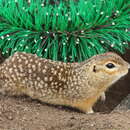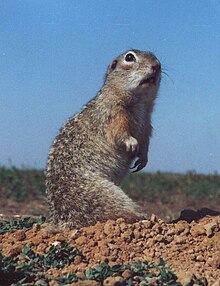en
names in breadcrumbs


Communication through vocalization plays a key role in the daily survival of speckled ground squirrels. They specialize in alarm calls that aid in alerting the colony of any potential predators. The speckled ground squirrel spends a vast majority of its time searching for predators, so they have developed visual acuity over time. Their alarm calls may be specialized to individuals in some cases. One good examples occurs when females develop individualized alarm calls when juvenile dispersal occurs.
Communication Channels: acoustic
Perception Channels: visual ; tactile ; acoustic ; ultrasound ; chemical
Currently speckled ground squirrels are near threatened, and completely protected in Poland under national law. They are also listed as endangered in the Polish Red Data Book and considered a Priority Species in the European Union Habitats Directive. There have been five newly constructed nature reserves in Poland to aid population conservation efforts. It has been proposed to use translocation for individuals from large colonies to boost genetic variation in other colonies at risk of deleterious genetic effects of bottlenecks. Agriculture has diminished much of their native habitat, and efforts to rebuild have been pursued.
US Federal List: no special status
CITES: appendix ii
State of Michigan List: no special status
There are no known adverse effects of the speckled ground squirrel (Spermophilus suslicus) on humans.
Speckled ground squirrels have been studied on multiple levels from individuality in alarm calls to the dynamics of colonies of speckle ground squirrels. Studying these squirrels has allowed groups to learn more about conservation and population management.
Positive Impacts: research and education
Speckled ground squirrels have some influence on soil aeration and altering habitat. They are fossorial; each individual in the colony digs multiple burrows throughout a landscape, which ultimately enhances soil aeration. Though they are only digging burrows they are also creating possible shelter for other species.
Ecosystem Impact: creates habitat; soil aeration
Speckled ground squirrels are most commonly be found eating sprouts. In some cases they eat grains, insects, and grasses. Some speckled grounds squirrel diets consist of bunch grasses (Festuca rubra) and motley grasses (Fragaria viridis, Eryngium planum, Pimpinella saxigraga).
Animal Foods: insects
Plant Foods: roots and tubers; seeds, grains, and nuts; flowers
Primary Diet: herbivore (Granivore )
The geographic range of speckled ground squirrels (Spermophillus suslicus) occurs in the Palearctic range, specifically eastern Europe. Their range extends east from a small portion in south-eastern Poland towards the Volga River in central Russia. The distribution of speckled ground squirrels occurs in most parts of Ukraine and Moldova. Small fragmented populations are present in east and western parts of Belarus.
Biogeographic Regions: palearctic (Native )
Speckled ground squirrels can occupy an array of habitats throughout the Palearctic range. Their typical habitat is the steppe areas or steppe meadows that occur throughout their north central distribution. They also tend to prefer cultivation sites, pasturelands, and open areas with low lying vegetation.
Range elevation: 0 to 500 m.
Habitat Regions: temperate ; terrestrial
Terrestrial Biomes: savanna or grassland
Other Habitat Features: agricultural
Speckled ground squirrels on the high end can reach an age of six years. Juveniles are more vulnerable and less likely to make it through the first year. As juveniles, they contribute to 73% of the mortality rate, while adults only contribute to 58% of the mortality rates. There are no records of the speckled ground squirrels in captivity.
Range lifespan
Status: wild: 6 (high) years.
Speckled ground squirrels are a small ground dwelling diurnal rodents, with an elongated body and short tail. They can reach lengths of 190 to 220 mm, and weigh from 180 to 220 g. The unique characteristic they can be identified by is the white tipped hairs that ultimately make up a speckled arrangement on the dorsal side of the body. They are predominately dark brown with a light cream color on their undersides, and they have short powerful legs. Speckled ground squirrels occur in the squirrel family, and have three subspecies: Spermophilus suslicus guttatus, S. s. boristhenicus, and S. s. suslicus. Speckled ground squirrels are easily identifiable and distinguished by their prominent white specks across its back. Juveniles or pups do not leave the den until maturity is reached, making it difficult to distinguish by color. European ground squirrels are closely related and may cause some identification issues due to similarities in appearance. European ground squirrels can be identified from their light brown coloration and white region from its jugular down the ventral side.
Range mass: 180 to 220 g.
Range length: 190 to 220 mm.
Other Physical Features: endothermic ; heterothermic ; bilateral symmetry
Sexual Dimorphism: sexes alike
Speckled ground squirrels have evolved certain anti-predator adaptions over time. Their main anti-predator adaption is the acoustic communication between individuals in the colony allowing them to alert the colony of predators within close proximity. Speckled ground squirrels are fossorial, allowing for them to easily escape predation by going underground. They have very good eyesight, relentlessly observing the surroundings for potential predators.
Known Predators:
Anti-predator Adaptations: cryptic
During the mating season just after females have emerged from hibernation, males use individuality in calls to attract females, and deter other males. They only breeds once a year right after hibernation. The males will mate with multiple females, and the females will raise the pups in a colony. Many of these colonies are experiencing population bottlenecks, raising the probability of inbreeding.
Mating System: polygynous
Speckled ground squirrels breed once yearly. Their breeding season occurs for two weeks as the females emerge from hibernation. Due to climatic conditions, they tend to have low intensity of breeding and low fertility rates. During late April and early May pups are born; these pups typically spend one month in the burrow until they disperse from the den. Information for gestation period and litter size is insufficient, however they can be compared to close relatives European ground squirrels. The gestation period of European ground squirrels lasts 27 days and the litter size on average is 6 pups.
Breeding interval: Speckled ground squirrels breed once yearly.
Breeding season: Speckled ground squirrels breed in March to April after they emerge from hibernation.
Average number of offspring: 6.
Average gestation period: 27 days.
Average weaning age: 30 days.
Range time to independence: 3 to 5 weeks.
Average age at sexual or reproductive maturity (female): 1 years.
Average age at sexual or reproductive maturity (male): 1 years.
Key Reproductive Features: iteroparous ; seasonal breeding ; gonochoric/gonochoristic/dioecious (sexes separate); sexual ; viviparous
Speckled ground squirrels give birth to a litter in early spring, with an average of 6 pups per litter. These pups are born underground, giving them protection from the elements and predators. Females tend to care for and protect the litters. Over the course of the weaning period, juveniles adapt to and learn alarm calls. It is noted that selective calling to juveniles and call rate is directly correlated to the emergence of young pups out of the den, suggesting there is some parental care. They spend much of their time viewing their surroundings and sounding alarm calls when predators are near, alarming the colony to take shelter.
Parental Investment: altricial ; pre-hatching/birth (Provisioning: Female, Protecting: Female); pre-weaning/fledging (Provisioning: Female, Protecting: Female); pre-independence (Provisioning: Female, Protecting: Male, Female)
The speckled ground squirrel or spotted souslik (Spermophilus suslicus) is a species of rodent in the family Sciuridae from Eastern Europe.[2] Spermophilus suslicus consists of three subspecies: S. s. boristhenicus, S. s. guttatus, and S. s. suslicus.[3] It is threatened by habitat loss.
The speckled ground squirrel has dark-brown fur with white spots on its back and a short, thin tail. It grows to a length of 25 cm (10 in) and a weight of 280 g (10 oz). Its dental formula is 1.0.2.31.0.1.3. It is smaller and less social than many other ground squirrels of the genus Spermophilus.[4]
It is found in Belarus, Moldova, Poland, European Russia, and Ukraine. Its natural habitat is temperate grassland and it is also found on cultivated ground. It is threatened by the loss and fragmentation of its habitat. Causes of habitat loss include the expansion of agriculture and forestry, the reduction of pasturing, the development and growth of cities, and industrial development. Also, in some areas it is hunted as an agricultural pest.[1][5]
The speckled ground squirrel's range in Poland and southern Russia has contracted markedly, with only 10% of its area in the mid-twentieth century currently remaining. At the current rate of contraction of its range, the speckled ground squirrel will be extinct from Poland within the next couple decades.[1]

The speckled ground squirrel is a diurnal species which hibernates from October to April. It is active in the morning once the sun warms the area slightly, retreats to its underground den during the heat of the day, then reemerges late in the day for another feeding bout. It feeds mostly on grasses and cereals, although small vertebrates and arthropods are also eaten.[6]
Compared with other Spermophilus species, it lives in a relatively closed habitat with high grasses that block visibility during its active seasons.[4] Individuals live in separate burrows within a larger colony. These colonies can be up to over 160 individuals per ha. It mates between April and May. Gestation ranges from 23 to 26 days. Four to eight cubs are born per litter.[7] Sporadic hybridization occurs where S. suslicus occurs sympatrically with S. pygmaeus and S. citellus.[3]
Though there have been no quantitative studies on all the predators of S. suslicus, the weasel Mustela nivalis has been known to enter burrows and cause significant juvenile mortality, though it does not attack adults.[8] However, conspecific predation may be more of a threat to the juvenile speckled ground squirrel than interspecific predators. Though infanticide in the wild has not yet been reported, the speckled ground squirrel has been infanticidal in captivity. The killer can be male, female, or both, and either eats the young or attacks and leaves it to die.[8]
The speckled ground squirrel uses alarm calls for a variety of purposes. Primarily, the alarm call is used to warn conspecific squirrels of predators and to alert predators that they've been detected [4] Individual-specific alarm calls have been seen in Spermophilus suslicus which also contain age-related features but they lack the ability to distinguish between familiar and unfamiliar individuals nor can they distinguish sex.
The speckled ground squirrel or spotted souslik (Spermophilus suslicus) is a species of rodent in the family Sciuridae from Eastern Europe. Spermophilus suslicus consists of three subspecies: S. s. boristhenicus, S. s. guttatus, and S. s. suslicus. It is threatened by habitat loss.